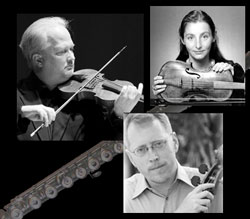|
Symphony
FROM THE NEW WORLD TO THE OLD WORLD
by Peter Lert
Saturday, June 14, 2025
Chamber
MC2 DUO RECITAL CLOSES 222'S SEASON
by Terry McNeill
Saturday, June 14, 2025
Choral and Vocal
CANTIAMO SONOMA'S LUSCIOUS A CAPELLA SINGING IN SEASON ENDING CONCERT
by Pamela Hicks Gailey
Sunday, June 8, 2025
Symphony
SRS SEASON ENDS WITH RESOUNDING TA-TA-TA-BANG
by Terry McNeill
Sunday, June 1, 2025
Symphony
YOUTHFUL VIRTUOSITY ON DISPLAY AT USO'S MAY CONCERTS
by Peter Lert
Saturday, May 17, 2025
Symphony
MYSTICAL PLANETS AND LIVELY GERSHWIN ORTIZ AT FINAL SRS CONCERT
by Peter Lert
Sunday, May 4, 2025
Symphony
VSO'S CONCERT MUSIC OF TIME, MUSIC OF PLACE
by Peter Lert
Sunday, April 27, 2025
VOCAL ELEGANCE AND FIRE AT THE 222'S RECITAL APRIL 26
by Pamela Hicks Gailey
Saturday, April 26, 2025
CANTIAMO SONOMA SINGS AN INSPIRED GOOD FRIDAY MOZART REQUIEM CONCERT
by Pamela Hicks Gailey
Friday, April 18, 2025
DRAMATIC SHOSTAKOVICH SYMPHONY CLOSES PHILHARMONIC'S 25TH SEASON
by Terry McNeill
Sunday, April 13, 2025
|
 |
 David Wilson, Kati Kyme and David Morris |
A ROYAL SCHOOLING IN THE CLASSICAL ERA
by Joanna Bramel Young
Saturday, January 23, 2010
On Jan. 23, the Redwood Arts Council showcased …cole Royale, a period instrument ensemble, in a chamber concert in Occidentalís charming and acoustically fine Community Church. This year is the Councilís 30th anniversary, and an enthusiastic and animated audience filled the room.
…cole Royale includes Sonoma Countyís own Kathleen Kraft on classical flute, along with Kati Kyme, violin, David Wilson, viola, and David Morris, cello. The concert featured a delightful collection of works by composers from the Classical era, including Abel, Mozart, Devienne, Haydn and early Beethoven.
The first work on the program was the Quartet in A Major by Carl Friedrich Abel (1723-1787). The soft flute contrasted nicely with the three strings, all played with period bows and gut strings. Here and there the strings slightly overpowered the flute, but only when it was playing in its lower register. The classical flute, which has only one key, has the ability to diminuendo to almost nothing without going out of tune, and the sensitive phrasing allowed flute and strings to achieve exceptionally subtle pianissimos.
Next on the program was the Duo in G Major for violin and viola by Mozart. The virtuosic interplay between the strings showed the facility of the players to full advantage. The rich low sounds from the viola were an effective contrast to the higher violin. Phrasing and gesture are so important in early music, and the group always played with the knowledge of where the phrase was going.
The early Beethoven Serenade in D Major for flute, violin and viola was, for this reviewer, the high point of the concert. In the opening Entrata the flute began all alone, then the violin and viola, playing in unison, echoed the fluteís melody. The Entrata had a charming bird-like feel to it, bringing to mind Mozartís Magic Flute. The Minuet was a set of variations, giving the flute a chance to show its virtuosity; strings and flute took turns showing their brilliance. The flute balanced beautifully with the strings in the Beethoven, as its part was written in a fairly high register Ė making it easier to hear.
The entire ensemble then played Haydnís Divertissement II in G Major. The cello particularly stood out, with its lovely, clear light tone, which exquisitely balanced the ensemble.
The Sonata in E Minor by Francois Devienne (1759-1803) was originally written for flute and bassoon. It is a big sonata for the flute, offering a variety of moods and affecting melodies. Kraft was at the top of her form in this work.
As an appropriate finale for the evening the entire ensemble joined for the familiar Quartet in D Major for flute, violin, viola and cello by Mozart. Kraft easily negotiated the elegant runs throughout the first Allegro. In the Adagio the plaintive flute melody floated above the pizzicato strings, which faithfully imitated the sound of an accompanying mandolin. The last movement, a Rondeau, sent the audience home humming Mozartís happy tune Ė a fitting end to a fine evening.
|
